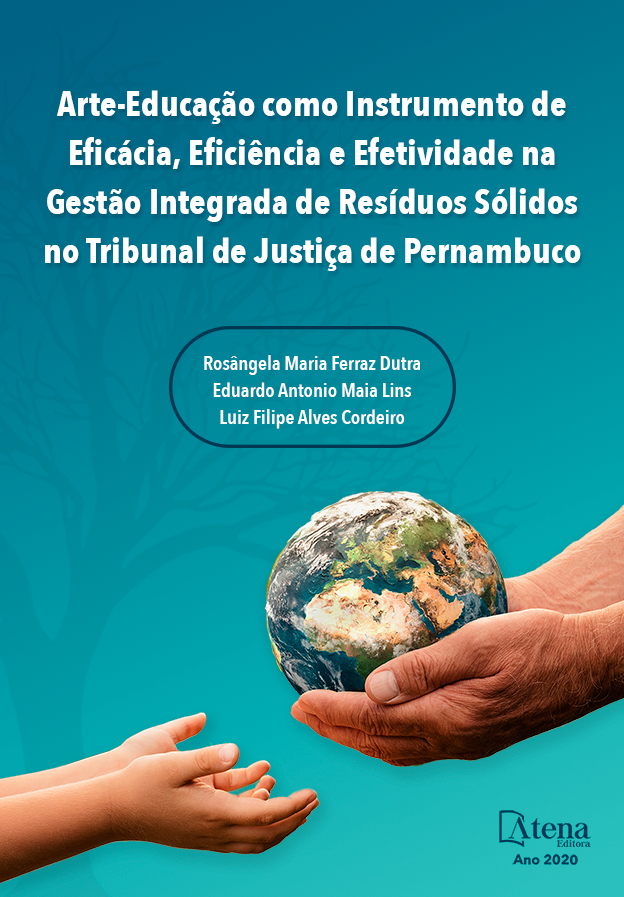
ARTE-EDUCAÇÃO COMO INSTRUMENTO DE EFICÁCIA, EFICIÊNCIA E EFETIVIDADE NA GESTÃO INTEGRADA DE RESÍDUOS SÓLIDOS NO TRIBUNAL DE JUSTIÇA DE PERNAMBUCO
Os recursos naturais sempre foram utilizados para a sobrevivência humana. Como são finitos, seu uso irracional torna a realidade insustentável e coloca em risco a própria existência humana. Este cenário exige adoção de medidas urgentes voltadas à sensibilização da sociedade. A Educação Ambiental é instrumento básico para implementar algum programa ou projeto ambiental. Torna-se, então, relevante conhecer os métodos adequados à divulgação da informação, assim como desenvolver modos de avaliação, o que vai permitir aferir-se se tais métodos conseguem promover melhores resultados. Esta pesquisa se propôs a examinar em que consiste a Arte-Educação e seu nível de eficácia, eficiência e efetividade com o objetivo de identificar quais ferramentas são consideradas mais atraentes à conscientização/sensibilização para a gestão integrada de resíduos sólidos. Para tanto, estudou-se a percepção socioambiental dos servidores. Interveio-se no estudo através da música e da poesia, com a atividade educativa “Amor, a linguagem para florescer o meio”. O trabalho foi realizado no II Tribunal do Júri do Recife, cuja competência para julgar os crimes dolosos contra a vida motivou a escolha. A amostra abrangeu 100% do universo estudado, totalizando 25 participantes. Utilizou-se o método exploratório-descritivo e a abordagem quali-quantitativa, além dos procedimentos éticos-legais, da pesquisa bibliográfica, documental e de campo. Os dados foram coletados por meio da aplicação de questionários. A análise textual concentrou-se no conteúdo das respostas. Para 100% dos participantes, a arte-educação é eficaz, eficiente e efetiva para a conscientização ambiental. Apuraram-se as artes visuais, cênica, digital e literária como ordem de preferência à sensibilização. Obtiveram-se, como resultados negativos, o baixo índice de participação nos programas e atividades realizadas pela instituição e a pouca valorização do servidor. Concluiu-se que a maior dificuldade para a execução da gestão ambiental são os paradigmas culturais. Também, que a utilização concomitante de recursos como a arte-educação, educação ambiental e percepção ambiental potencializa a promoção de mudanças na maneira de pensar, sentir e agir das pessoas e orienta ao alcance da sustentabilidade. Sugere-se reavaliação e maior investimento na política de valorização de servidor e na regularidade na promoção de ações educativas, visando à consecução de uma gestão mais eficaz, eficiente e efetiva.
ARTE-EDUCAÇÃO COMO INSTRUMENTO DE EFICÁCIA, EFICIÊNCIA E EFETIVIDADE NA GESTÃO INTEGRADA DE RESÍDUOS SÓLIDOS NO TRIBUNAL DE JUSTIÇA DE PERNAMBUCO
-
DOI: 10.22533/at.ed.143200511
-
Palavras-chave: Percepção. Sensibilização. Conscientização ambiental. Ações educativas. Responsabilidade compartilhada.
-
Keywords: Perception. Awareness. Environmental awareness. Educational actions. Shared responsibility.
-
Abstract:
Natural resources have always been used for human survival. As they are finite, their irrational use makes reality unsustainable and endangers human existence itself. This scenario requires the adoption of urgent measures aimed at raising society’s awareness. Environmental Education is a basic instrument to implement an environmental program or project. It is, therefore, relevant to know the appropriate methods to disseminate the information, as well as to develop ways of evaluating them, as it will allow assessing whether they manage to promote better results. This research set out to consider what Art-Education consists of and its level of effectiveness and efficiency in order to identify which tools are considered most attractive to raise awareness of integrated solid waste management. To this end, the social and environmental perception of public servants was studied. We intervened in the study, through music and poetry, with the educational activity "Love, the language to flourish the environment". The work was carried out at II Tribunal do Júri do Recife (II Recife Jury Trial), whose competence of judging intentional crimes against life motivated the choice. The sample covered 100% of the universe studied, totaling 25 participants. The exploratory-descriptive method and the qualitative and quantitative approach were used, as well as ethical-legal procedures, bibliographic, documentary and field research. The data were collected through the application of questionnaires. The textual analysis focused on the content of the answers. For 100% of the participants, art education is effective and efficient for environmental awareness. Visual, scenic, digital and literary arts were chosen as an order of preference for raising awareness. As a negative result, the low rate of participation in programs and activities carried out by the institution and the little appreciation of the public servants were obtained. It was concluded that the greatest difficulty in carrying out environmental management is the cultural paradigms. Also, that the concomitant use of resources such as art education, environmental education and environmental perception enhances the promotion of changes in the way people think, feel and act and it guides the achievement of sustainability. It is suggested to reassess and invest more in the policy of valuing public servants and to promote regular educational actions aimed at achieving a more effective and efficient management.
-
Número de páginas: 143
- Eduardo Antonio Maia Lins
- Luiz Filipe Alves Cordeiro
- Rosângela Maria Ferraz Dutra


